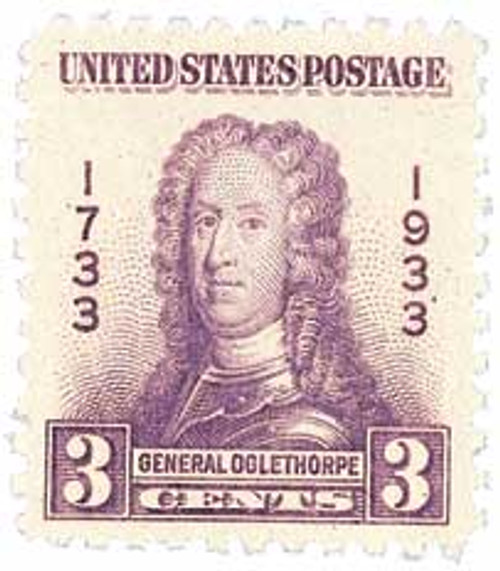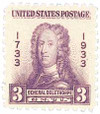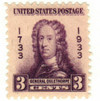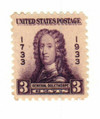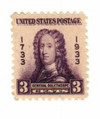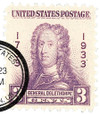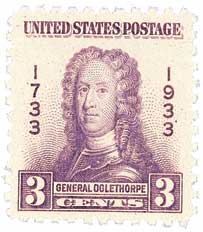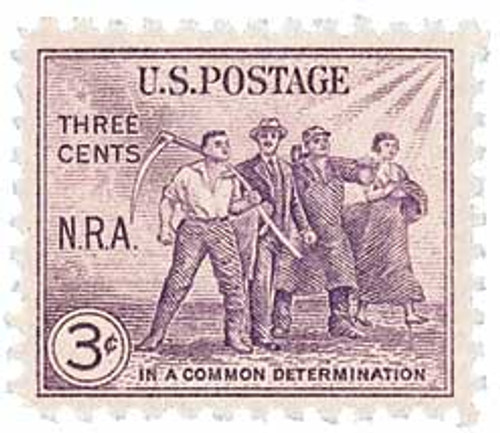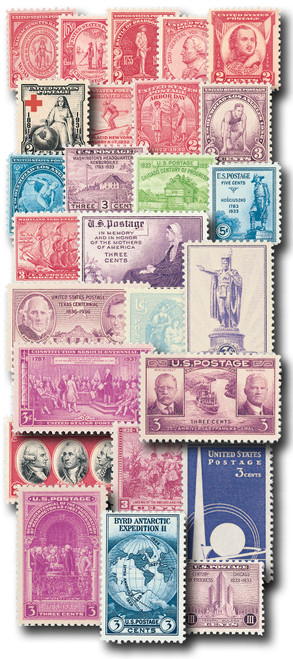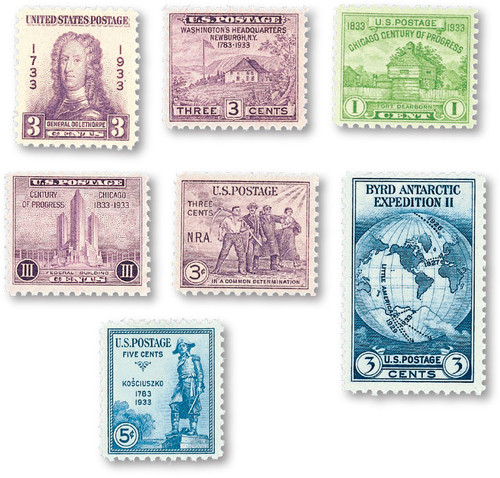
# 726 - 1933 3c General James Edward Ogelthorpe, Georgia Bicentennial
1933 3¢ Georgia Bicentennial
Issue Date: February 12, 1933
First City: Savannah, GA
Quantity Issued: 61,719,200
Birth Of James Oglethorpe
Born in Surrey, England, Oglethorpe briefly attended Corpus Christi College before joining the army of Prince Eugene of Savoy. Oglethorpe served as the prince’s aide-de-camp and served with distinction during the Austro-Turkish War of 1716-18.
After the war, Oglethorpe returned to England and was elected a Member of Parliament for Haslemere in 1722. He took a special interest in the British Royal Navy, anonymously publishing “The Sailors Advocate,” pushing for improved conditions.
In 1728, Oglethorpe served on a Parliamentary committee on prison reform. In this role he witnessed the horrible treatment in three debtors’ prisons. Many of these debtors were released from prison with no support. Many of these people then went to London where they were impoverished or became criminals.
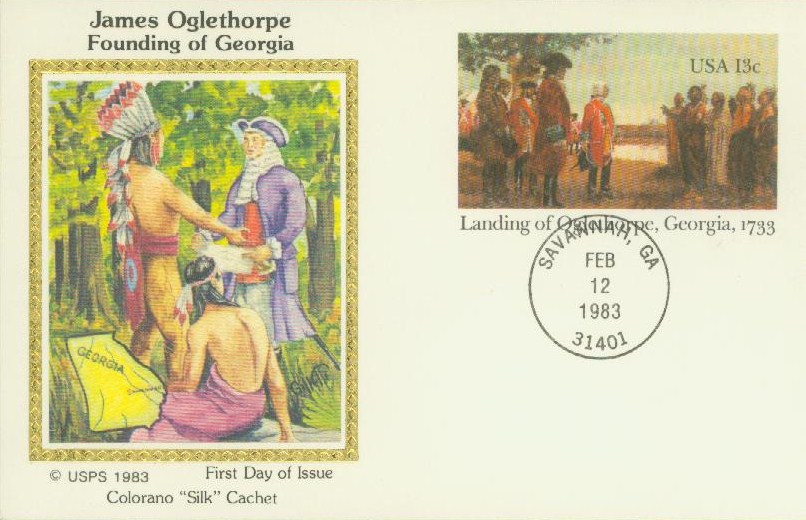
Oglethorpe believed he had the solution – to found a colony for debtors in America. In 1730, he and a group of like-minded individuals petitioned to form the Trustees for the Establishment of the Colony of Georgia in America. In 1732, Oglethorpe received a charter from George II for founding the colony, and Parliament granted him $50,000.
Oglethorpe and his partners developed a plan for the settlement (known as the Oglethorpe Plan) based on “agrarian equality.” Families could own up to 50 acres, including a town lot, garden plot near the town, and a 45-acre farm, though they could own more 50-acre plots if they wanted.
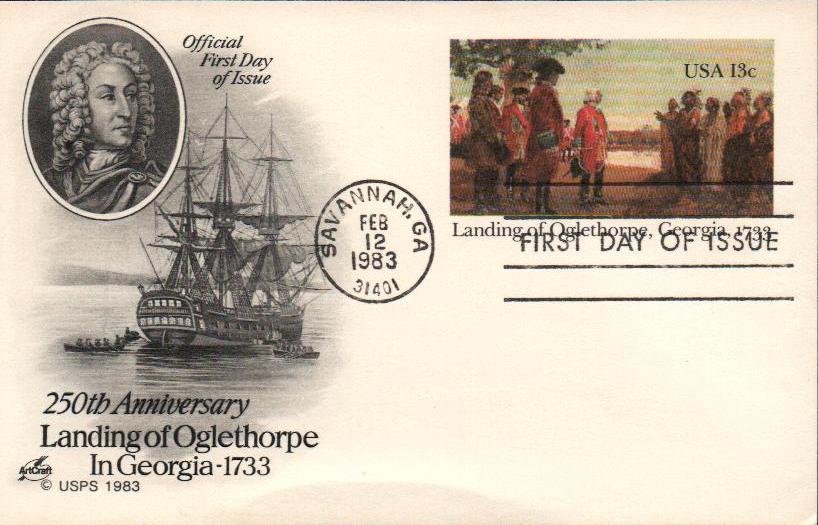
In November 1732, Oglethorpe and a group of about 120 colonists departed England to start their new colony. They arrived in South Carolina before the end of the year and settled near present-day Savannah, Georgia, on February 1, 1733. Oglethorpe negotiated with the Tamacraw tribe for their land and oversaw the building of a series of forts. He brought with him cottonseeds that helped to establish that industry in the American South.
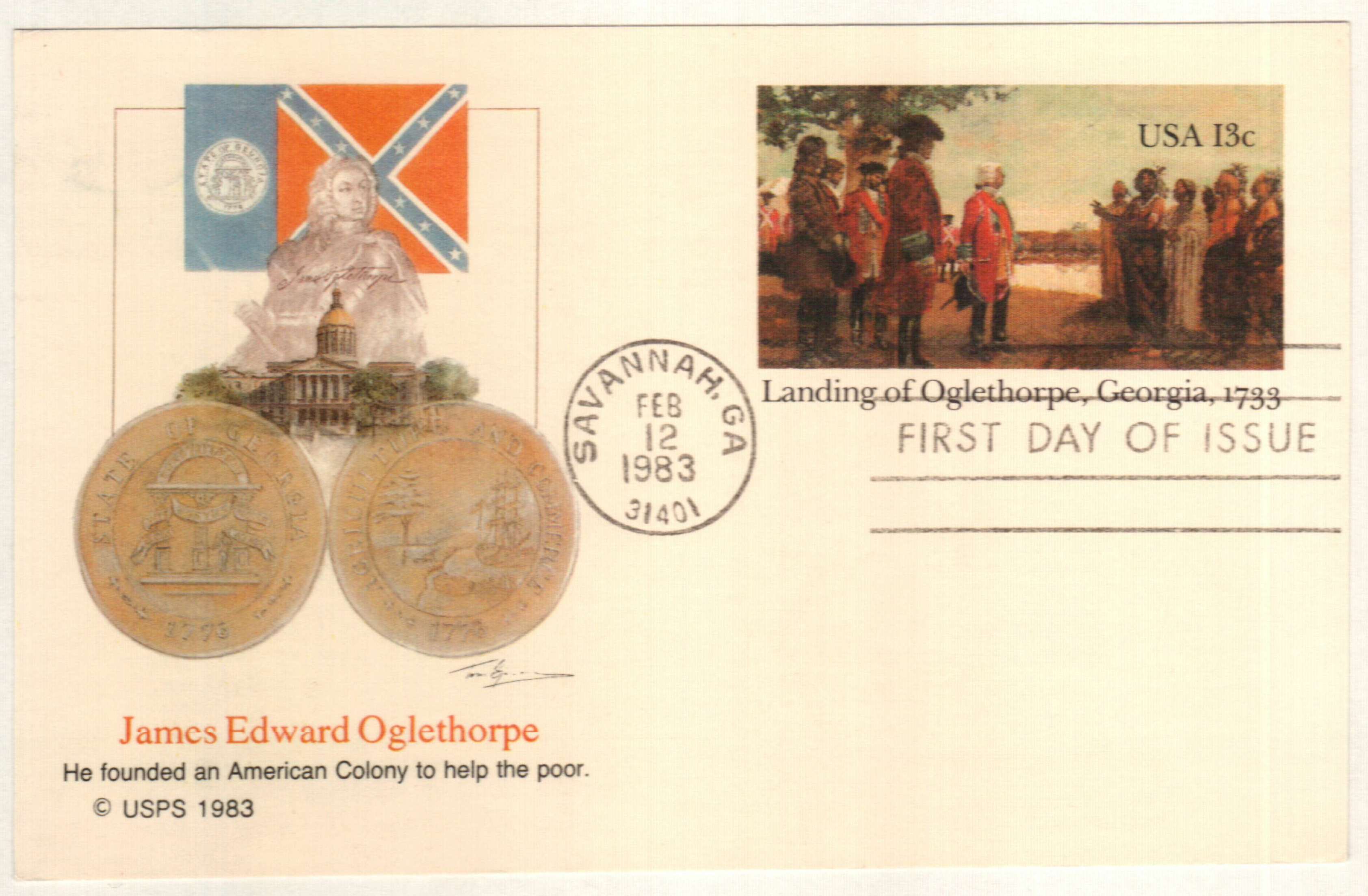
Contrary to Oglethorpe’s initial plan, few debtors settled in Georgia. It was largely Scots, poor English tradesmen and artisans, Swiss, French, German, and Jewish refugees, as well as Salzburger Protestants. The colony accepted all religions except for Roman Catholicism.
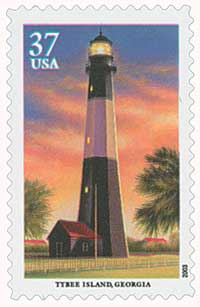
Shortly after their arrival, Oglethorpe ordered the construction of a lighthouse to aid boats arriving in the Savannah Harbor. Completed in 1736, the Tybee Island Lighthouse stood 90 feet tall, making it the tallest structure in Colonial America at the time. The lighthouse was destroyed by a storm five years later and then rebuilt four feet taller than the original.
In 1734, Oglethorpe established the first Masonic Lodge in Georgia. Known as Solomon’s Lodge, it’s the “Oldest Continuously Operating English Constituted Lodge of Freemasons in the Western Hemisphere.”
Oglethorpe proved to be an effective leader, governing for nine years. He also banned slavery in Georgia, but not because he was opposed to the idea of it. Having slaves in Georgia posed a potential threat to the colony’s military security. The Spanish enemy nearby in Florida offered slaves freedom in exchange for military service, which was a risk Oglethorpe wasn’t willing to take. But when he successfully drove back invading Spaniards at the Battle of Bloody Marsh in 1742, the threat was minimized. Oglethorpe left Georgia the following year, after which, the slavery ban was lifted.
In 1743, Oglethorpe returned to England and rose through the ranks of the British Army. He raised a unit of Rangers to send to Georgia to defend against Spanish attacks, but after an unsuccessful skirmish and court-martial, he never commanded troops again.
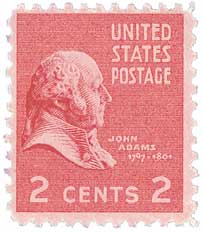
In 1785, Oglethorpe met US ambassador to Britain John Adams and admitted he was upset over the fighting that had taken place between the two countries. He also said that he had “great esteem and regard for America.” Oglethorpe died weeks later on June 30, 1785.
A town, county, and college in Georgia are all named in Oglethorpe’s honor. There’s also a statue by Daniel Chester French in Savannah. Oglethorpe is depicted with his sword drawn, facing south toward his former enemy, Spanish Florida.
1933 3¢ Georgia Bicentennial
Issue Date: February 12, 1933
First City: Savannah, GA
Quantity Issued: 61,719,200
Birth Of James Oglethorpe
Born in Surrey, England, Oglethorpe briefly attended Corpus Christi College before joining the army of Prince Eugene of Savoy. Oglethorpe served as the prince’s aide-de-camp and served with distinction during the Austro-Turkish War of 1716-18.
After the war, Oglethorpe returned to England and was elected a Member of Parliament for Haslemere in 1722. He took a special interest in the British Royal Navy, anonymously publishing “The Sailors Advocate,” pushing for improved conditions.
In 1728, Oglethorpe served on a Parliamentary committee on prison reform. In this role he witnessed the horrible treatment in three debtors’ prisons. Many of these debtors were released from prison with no support. Many of these people then went to London where they were impoverished or became criminals.

Oglethorpe believed he had the solution – to found a colony for debtors in America. In 1730, he and a group of like-minded individuals petitioned to form the Trustees for the Establishment of the Colony of Georgia in America. In 1732, Oglethorpe received a charter from George II for founding the colony, and Parliament granted him $50,000.
Oglethorpe and his partners developed a plan for the settlement (known as the Oglethorpe Plan) based on “agrarian equality.” Families could own up to 50 acres, including a town lot, garden plot near the town, and a 45-acre farm, though they could own more 50-acre plots if they wanted.

In November 1732, Oglethorpe and a group of about 120 colonists departed England to start their new colony. They arrived in South Carolina before the end of the year and settled near present-day Savannah, Georgia, on February 1, 1733. Oglethorpe negotiated with the Tamacraw tribe for their land and oversaw the building of a series of forts. He brought with him cottonseeds that helped to establish that industry in the American South.

Contrary to Oglethorpe’s initial plan, few debtors settled in Georgia. It was largely Scots, poor English tradesmen and artisans, Swiss, French, German, and Jewish refugees, as well as Salzburger Protestants. The colony accepted all religions except for Roman Catholicism.

Shortly after their arrival, Oglethorpe ordered the construction of a lighthouse to aid boats arriving in the Savannah Harbor. Completed in 1736, the Tybee Island Lighthouse stood 90 feet tall, making it the tallest structure in Colonial America at the time. The lighthouse was destroyed by a storm five years later and then rebuilt four feet taller than the original.
In 1734, Oglethorpe established the first Masonic Lodge in Georgia. Known as Solomon’s Lodge, it’s the “Oldest Continuously Operating English Constituted Lodge of Freemasons in the Western Hemisphere.”
Oglethorpe proved to be an effective leader, governing for nine years. He also banned slavery in Georgia, but not because he was opposed to the idea of it. Having slaves in Georgia posed a potential threat to the colony’s military security. The Spanish enemy nearby in Florida offered slaves freedom in exchange for military service, which was a risk Oglethorpe wasn’t willing to take. But when he successfully drove back invading Spaniards at the Battle of Bloody Marsh in 1742, the threat was minimized. Oglethorpe left Georgia the following year, after which, the slavery ban was lifted.
In 1743, Oglethorpe returned to England and rose through the ranks of the British Army. He raised a unit of Rangers to send to Georgia to defend against Spanish attacks, but after an unsuccessful skirmish and court-martial, he never commanded troops again.

In 1785, Oglethorpe met US ambassador to Britain John Adams and admitted he was upset over the fighting that had taken place between the two countries. He also said that he had “great esteem and regard for America.” Oglethorpe died weeks later on June 30, 1785.
A town, county, and college in Georgia are all named in Oglethorpe’s honor. There’s also a statue by Daniel Chester French in Savannah. Oglethorpe is depicted with his sword drawn, facing south toward his former enemy, Spanish Florida.

